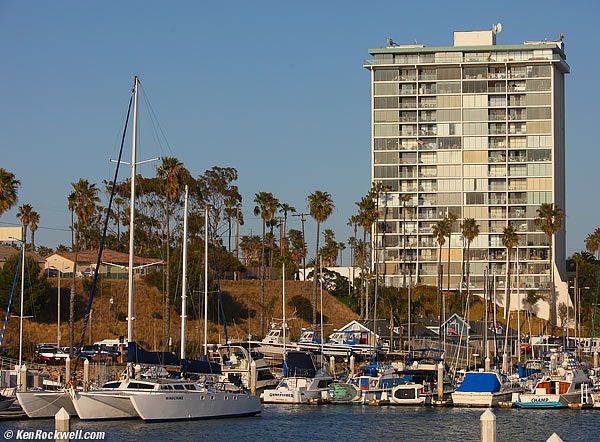Home Donate New Search Gallery Reviews How-To Books Links Workshops About Contact
Olde Southern California
02, 03 and 04 March 2012
These are snaps from Dave Wyman's photo tour of Olde Southern California.
Friday was the 25th anniversary of Canon's EOS autofocus camera system, so I shot my Canon 5D Mk II with Canon's first two professional zooms: my Canon EF 20-35mm f/2.8 L and 80-200mm f/2.8 L. (Pros never shot the Canon FD system, which is why Canon dumped the entire FD line unapologetically 25 years ago and replaced it with the completely incompatible EOS system; Canon said "screw amateurs, we're going for the pros, and when we get the pros, the rest will follow," and Canon was right. EOS is so incompatible with FD that the lens backfocus distances are such that there is no way to adapt an FD lens to anything, even though EOS lenses can.
I set my Canon 5D Mk II as per my Canon 5D Mk II User's Manual, which means I set a Picture Control (or whatever it's called, read my manual) to +4 for saturation, and set the Highlight Control (or whatever it's called) to D+. I set AUTO ISO and Pro ("P") exposure mode to let my camera figure out all the apertures and shutter speeds and ISOs. I also set AUTO White Balance, with A5 amber shift, and light metering on Evaluative. Everything was shot in JPG NORMAL.
I set everything as automatically as possible, since it gets me where I need to be faster. I know when I need to take something off manual and have to drive myself when needed.
My Canon's exposure compensation was usually at -2/3.
On Sunday, I shot a real Nikon and real Nikon F lenses: a 1971 Nikon F2 Photomic (an older, non-AI version of the Nikon F2AS that meters at full-aperture with real Nikon F lenses), a 20mm f/3.5 NIKKOR-UD Auto, 2.8cm f/2.8 Auto NIKKOR, 35mm f/2 NIKKOR-O Auto, 50mm f/1.4 NIKKOR, and an 85mm f/1.8 NIKKOR-H Auto, all genuine Nikon F mount lenses as shot by real photographers (non-AI, non-updated, non-converted real Nikon SLR lenses); none of this "automatic Indexing (AI)" baloney invented so any idiot could take pictures. Of course those photos are still on the film in the camera; you don't get instant results from real cameras, unless of course they're Polaroid.
I sorted the images in Phase One Media Pro, and once the not-too-bad ones were chosen, they were formatted for publication in Photoshop CS5. Lastly I then created these pages and uploaded it all in Macromedia Dreamweaver 8 from 2006.
02 March 2012, Friday skip to Saturday Sunday top
We met at the La Quinta motel in Oceanside at 2 PM, and I gave a short lecture about everything you'd ever need to know about making great photos. We headed to the Oceanside Marina.
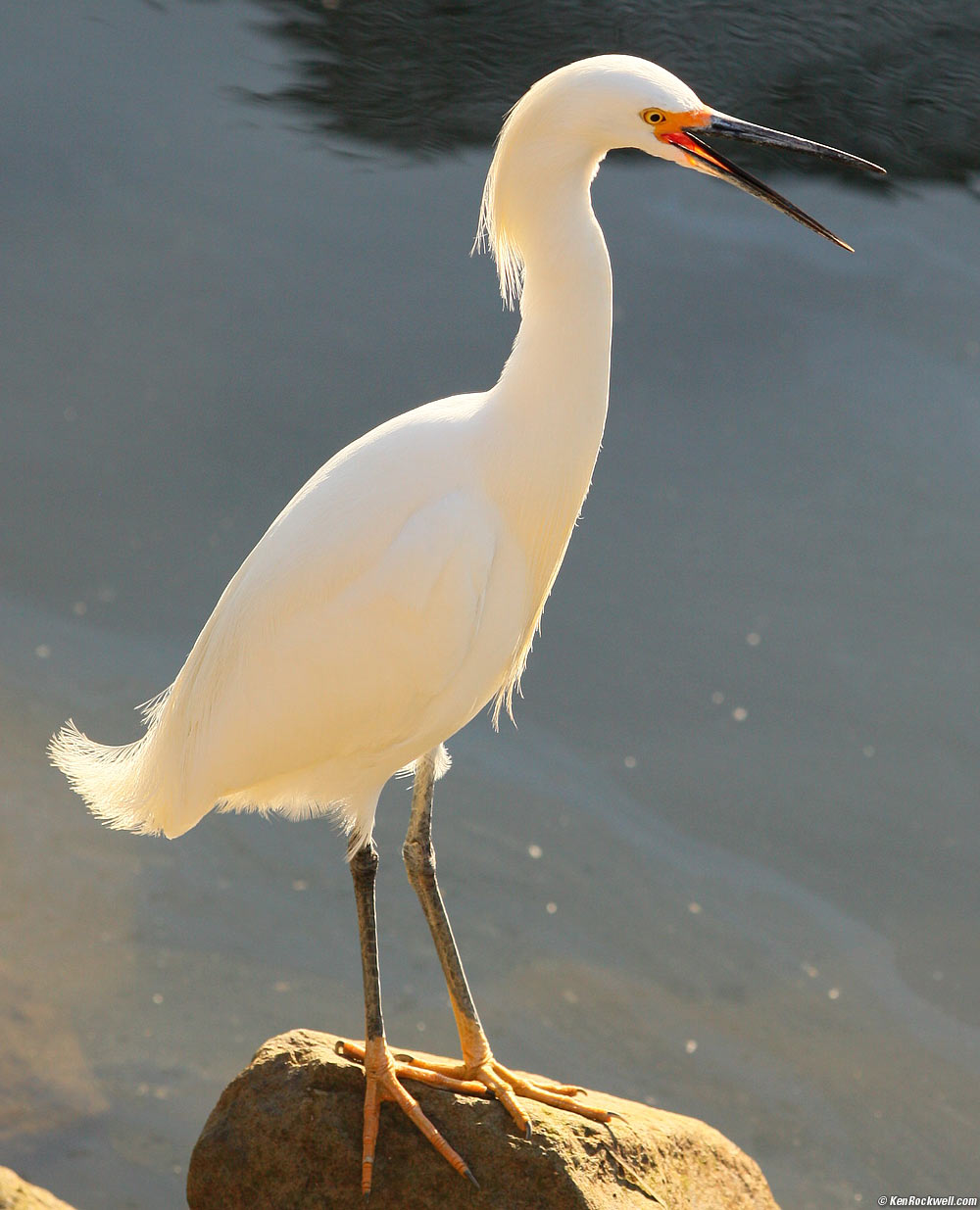
Egret, 3:38 PM. (Canon 5D Mark II, Canon EF 80-200mm f/2.8 L at 200mm, f/5 at 1/1,000 at AUTO ISO 200 D+.)
The 5D Mark II has so much resolution, and the 80-200mm f/2.8 L is so sharp, that there's no need for longer lenses. Here's the full-frame image from which I cropped the above:
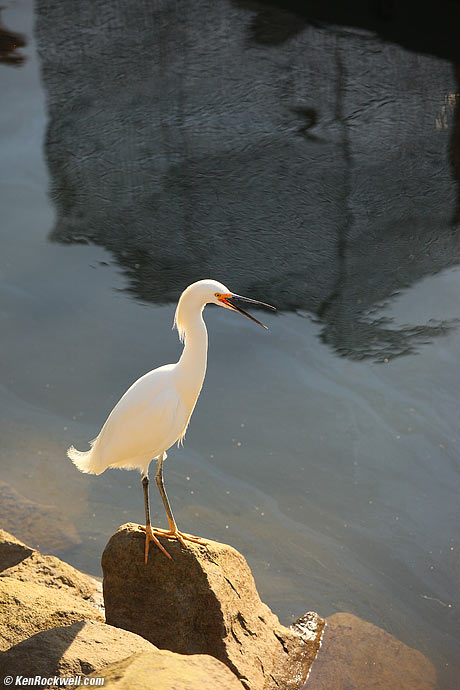
and here's a crop from it:

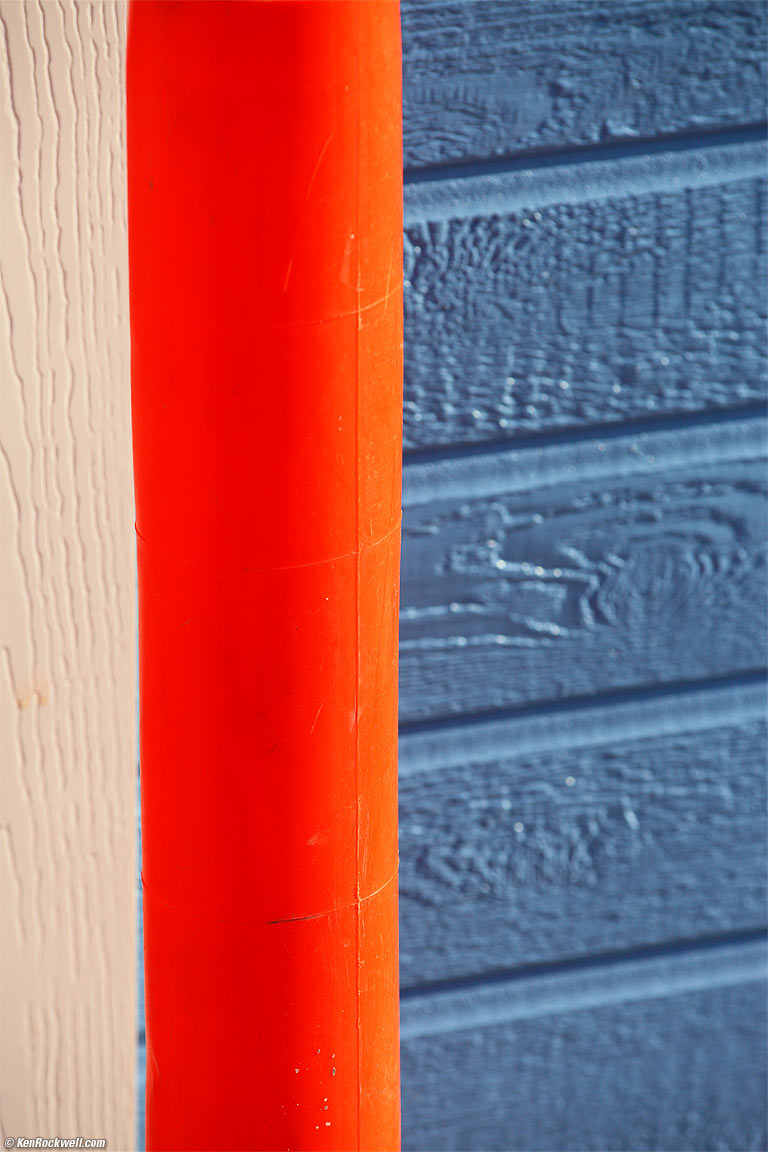
Orange and Blue, 3:45 PM. (Canon 5D Mark II, Canon EF 80-200mm f/2.8 L at 200mm, f/6.3 at 1/800 at AUTO ISO 200 D+.)
This is a plastic pole, but I used it as a band of orange against blue. The fact that it's a piece of plastic is irrelevant: the fact that it gives me a bold swath of orange against blue is everything. I didn't want the background sharp as it would distract, but I did want the orange-blue edge sharp.
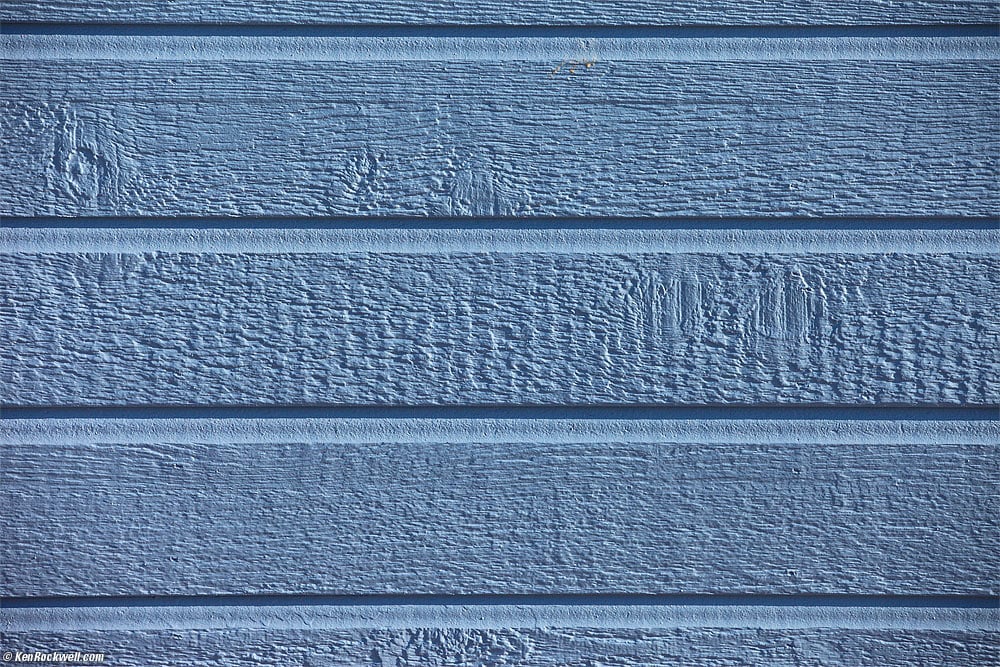
Blue Wall , 3:46 PM. (Canon 5D Mark II, Canon EF 80-200mm f/2.8 L at 165mm, f/6.3 at 1/800 at AUTO ISO 200 D+.)
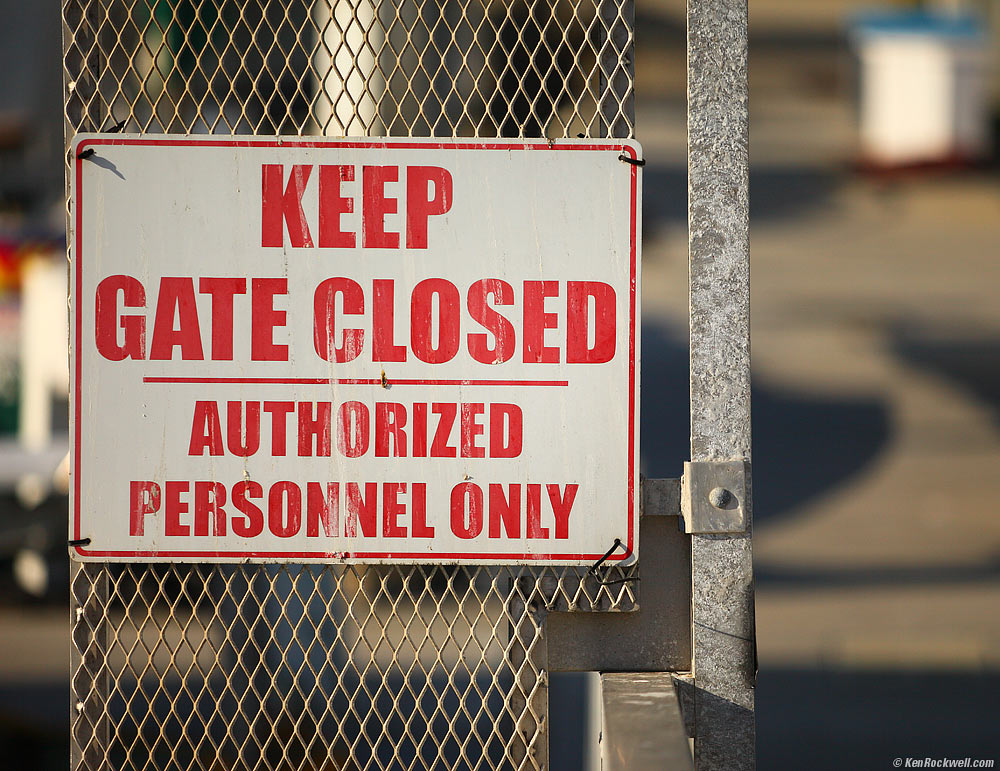
Gate, 3:47 PM. (Canon 5D Mark II, Canon EF 80-200mm f/2.8 L at 200mm, f/2.8 at 1/6,400 at AUTO ISO 200 D+.)
I wanted a soft background, so I chose f/2.8, the largest aperture, at the longest focal length. This makes the sharp sign pop out and look three-dimensional against the soft background.
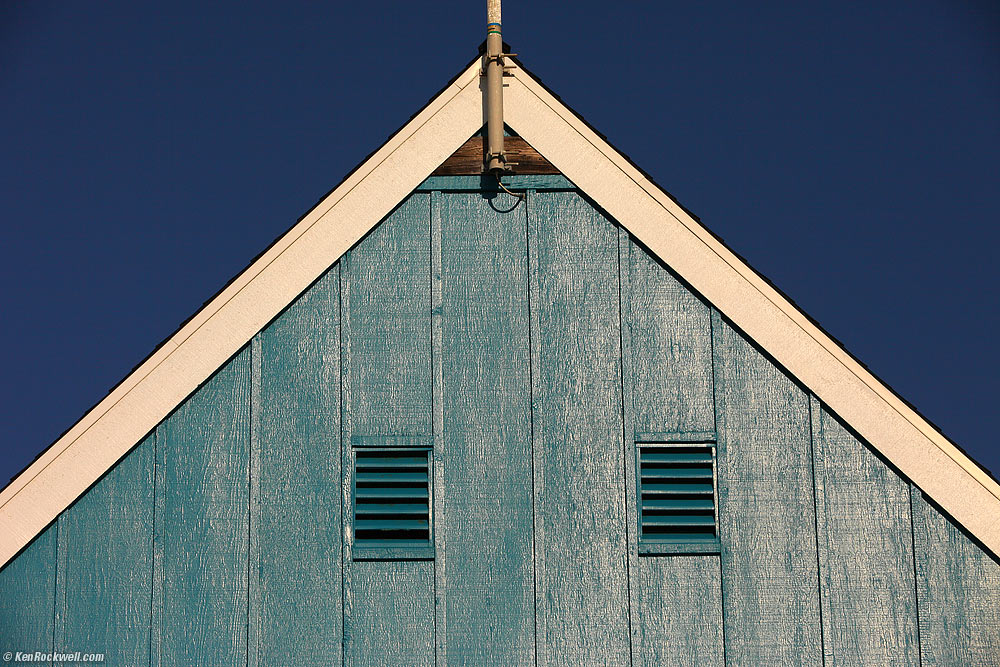
Blue V, 3:55 PM. (Canon 5D Mark II, Canon EF 80-200mm f/2.8 L at 140mm, f/10 at 1/1,600 at AUTO ISO 200 D+.)
This isn't a building, it's a white "V" against a blue background.
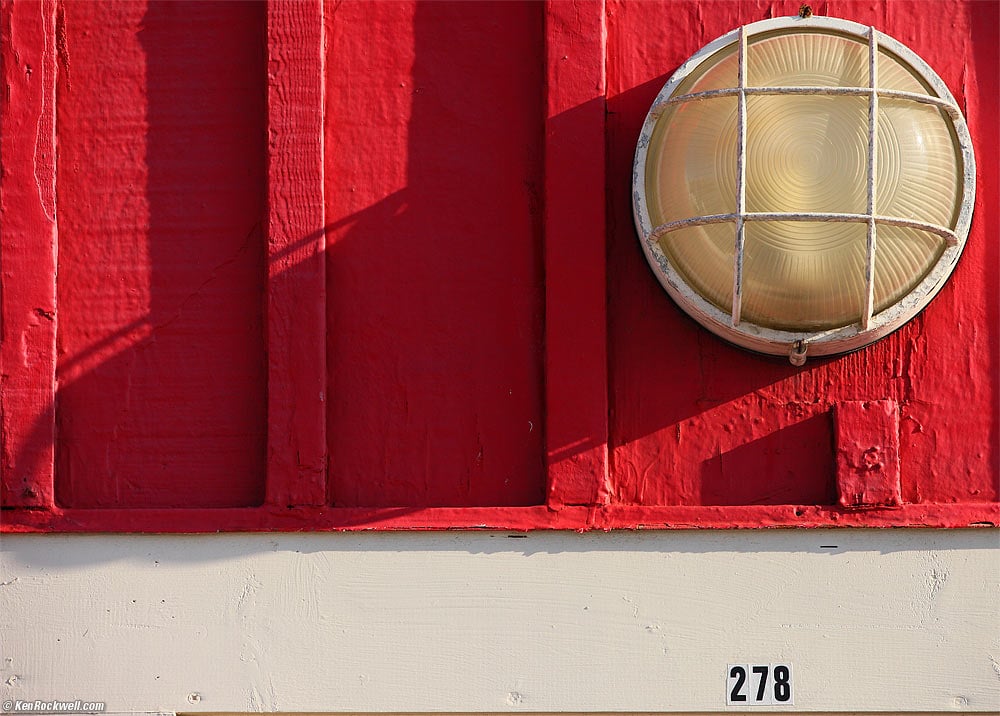
Red 278, 3:56 PM. (Canon 5D Mark II, Canon EF 80-200mm f/2.8 L at 140mm, f/6.3 at 1/800 at AUTO ISO 200 D+.)
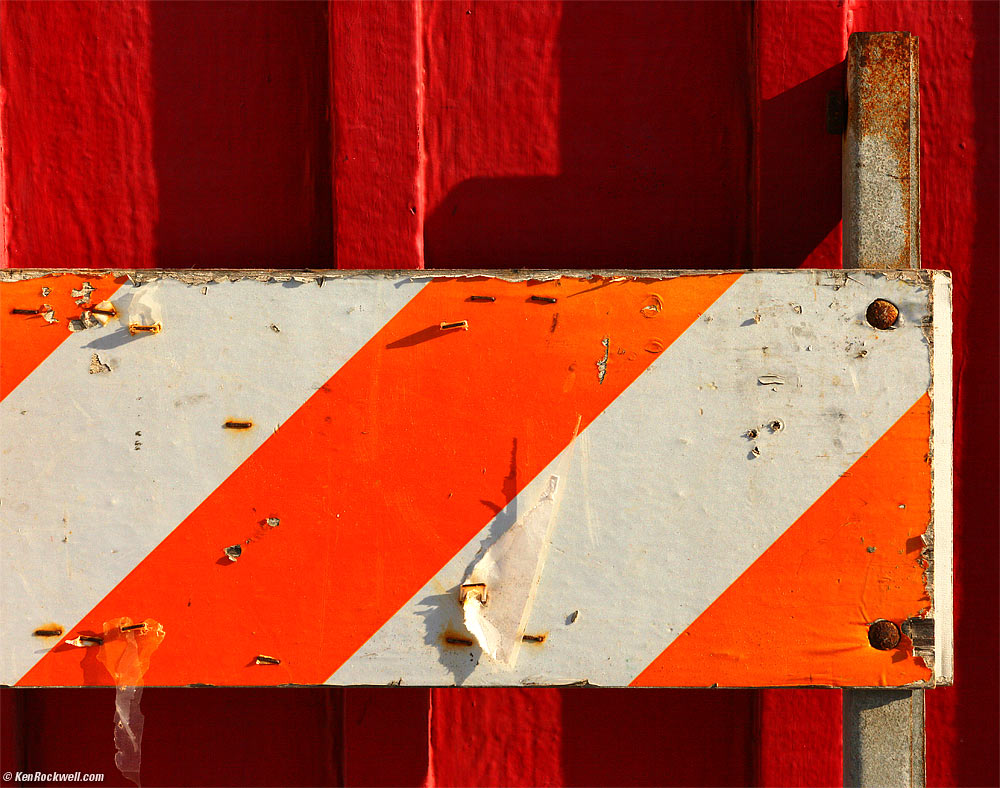
Orange, 3:57 PM. (Canon 5D Mark II, Canon EF 80-200mm f/2.8 L at 165mm, f/8 at 1/1,000 at AUTO ISO 200 D+.)
This isn't a photo of a road construction sawhorse, it's all about red, white and orange — and the whites aren't white; they're also orange.
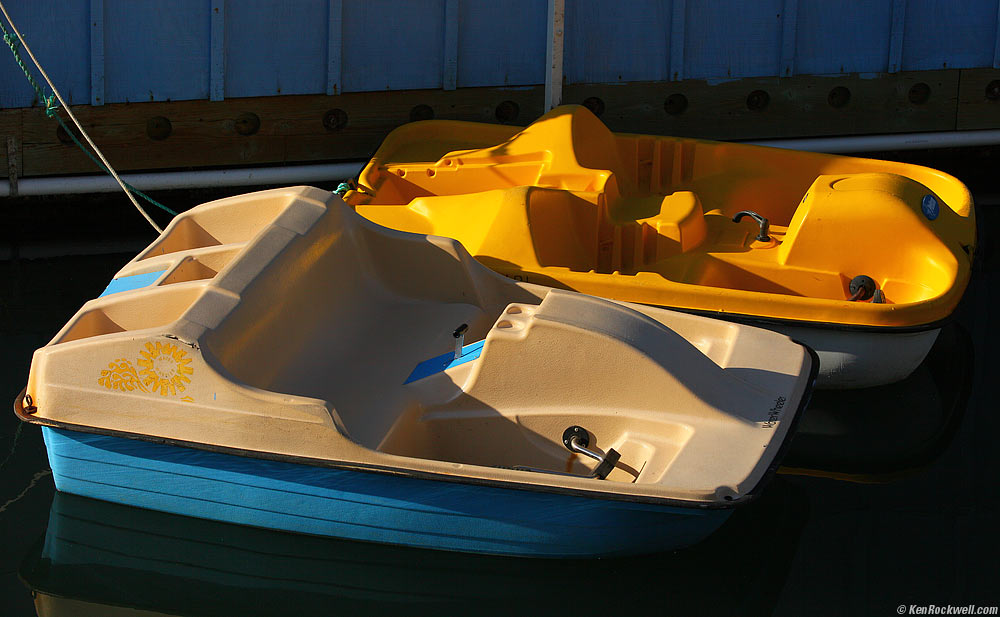
Yellow, Orange and Blue, 3:58 PM. (Canon 5D Mark II, Canon EF 80-200mm f/2.8 L at 110mm, f/8 at 1/800 at AUTO ISO 200 D+.)
Again, this isn't about two boats: it's yellow, orange and blue. The white boat isn't white; in this late light, its orange.
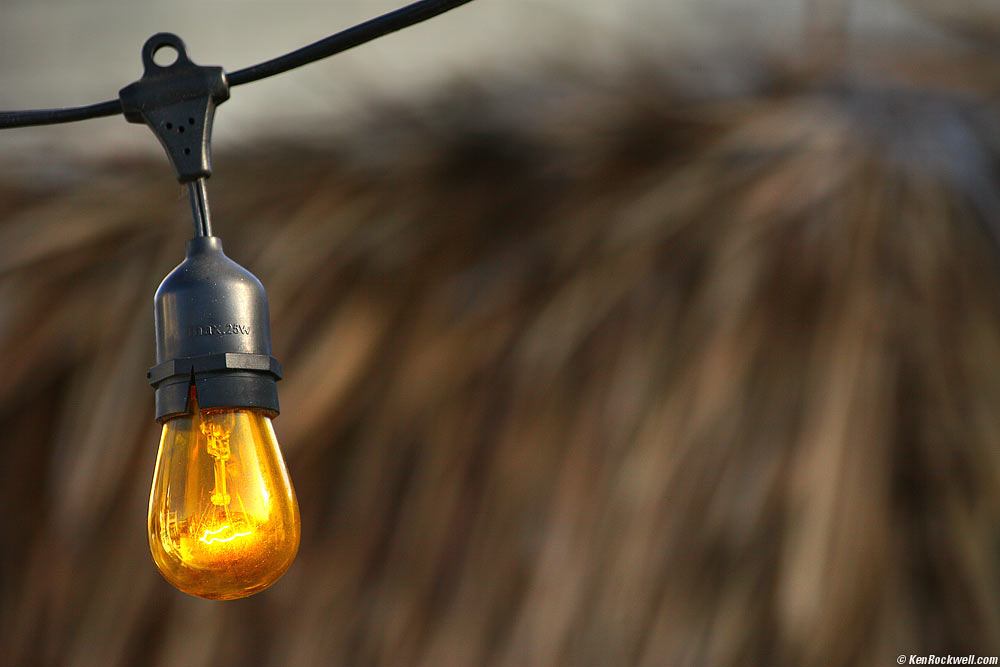
Bright Idea, 3:59 PM. (Canon 5D Mark II, Canon EF 80-200mm f/2.8 L at 200mm, f/5 at 1/500 at AUTO ISO 200 D+.)
I didn't open up to f/2.8 because I wanted all of the light in focus. Even at f/5, at 200mm with the light as close as it was, the background went away anyway and retained just enough texture to let us see it's a palapa, without drawing our eyes away with too much detail.
This is easy to preview by pressing the depth-of-field preview button.
It was by very deliberate design that I put the bulb in the lower left.
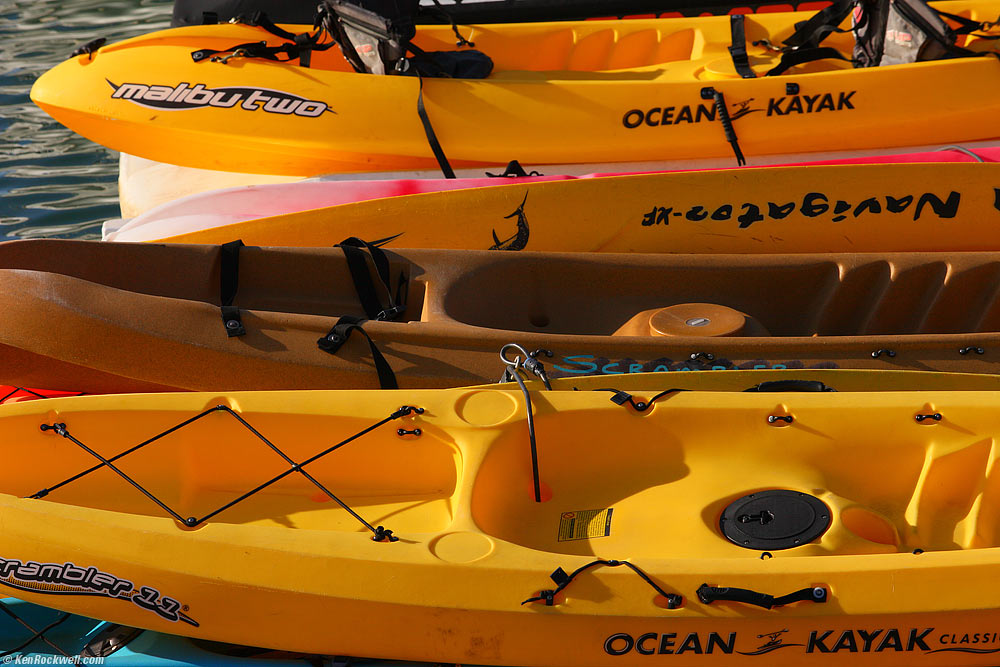
Kayaks, 4:00 PM. (Canon 5D Mark II, Canon EF 80-200mm f/2.8 L at 200mm, f/11 at 1/320 at AUTO ISO 200 D+.)
This is all about yellow in front of blue. Yellow comes forward and blue pushes back. If you have a yellow object in the foreground and blue in the background, it gives a three dimensional image. If you put blue in front of yellow, it's weaker because our brain is trying to push the blue back behind the yellow.
I wanted all the kayaks in focus, so I shot at f/11. I change my apertures as simply as flicking the 5D Mark II's rear dial, never leaving Pro ("P") exposure mode.
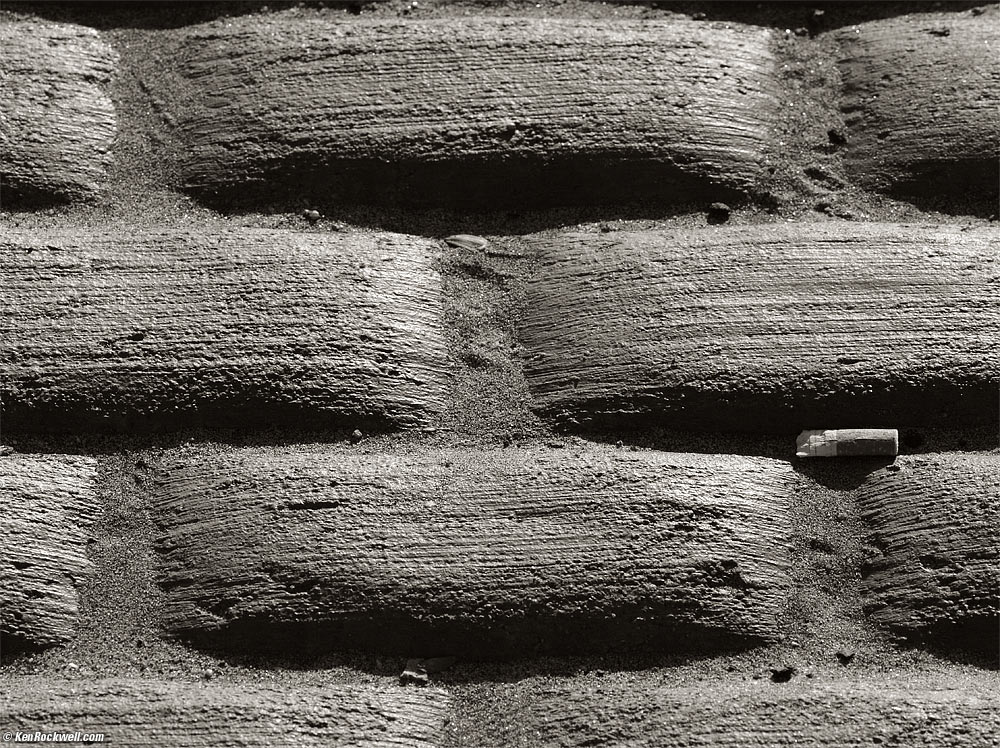
Pig Dropping, 4:10 PM. (Canon 5D Mark II, Canon EF 80-200mm f/2.8 L at 200mm, f/18 at 1/200 at AUTO ISO 200 D+.)
The pig dropping is merely a point of interest in a sea of imitation concrete bricks. I wanted more in focus, so I flicked the 5D Mark II's rear dial to give a smaller aperture while in Pro ("P") exposure mode.
I split-toned this electronically; this shot has no need for color.
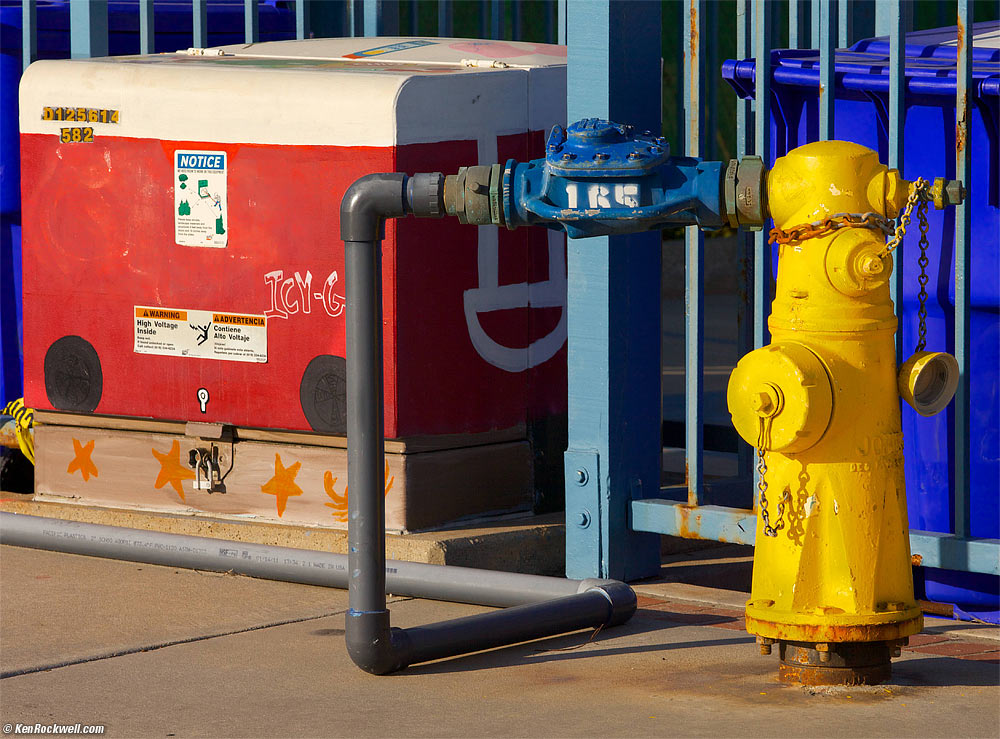
Primary Colors, 4:14 PM. (Canon 5D Mark II, Canon EF 80-200mm f/2.8 L at 200mm, f/11 at 1/400 at AUTO ISO 200 D+.)
Know the three most important things in any color photograph? Color, color and color.
If you're shooting in color, use color. If color isn't critical to what you're trying to say, stay in black-and-white.
The basics of this image are the three primary colors. It has nothing to do with a fireplug, a fence, a trash can and a power transformer.
I snapped this in CR2 (raw), and burned and dodged it in Aperture 3.
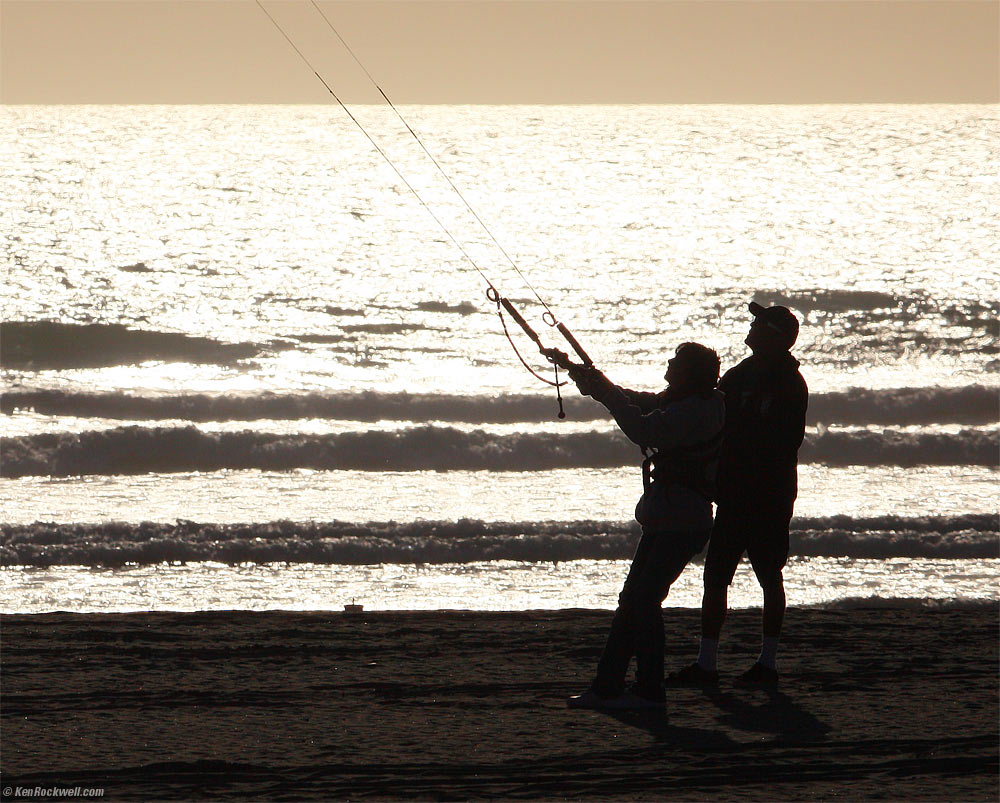
Flying, 4:15 PM. (Canon 5D Mark II, Canon EF 80-200mm f/2.8 L at 200mm, f/9 at 1/8,000 at AUTO ISO 200 D+.)
OK, this shot really is about what it appears to be: just a happy couple flying a big kite. I was too lazy to spot-out the drink.
No need for long lenses; here's the full-frame snap:

And here's how sharp it is if you need to crop more:
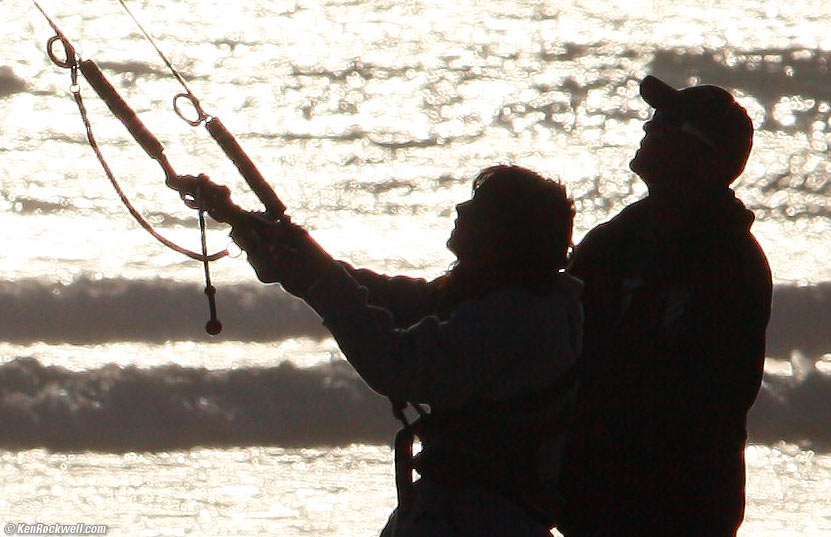
Flying, 4:15 PM. (Canon 5D Mark II, Canon EF 80-200mm f/2.8 L at 200mm, f/9 at 1/8,000 at AUTO ISO 200 D+.)
Look at the lens' and 5D Mark II,'s ability to see into the shadows, even against the blinding direct sunlight, just as JPGs.
While I'm sidetracked extolling the virtues of Canon and my 20-year-old EF 80-200mm f/2.8 L, here's a sharpness example I added to it's review:
Oceanside Marina, 4:18 PM. (Canon 5D Mark II, Canon EF 80-200mm f/2.8 L at 115mm, f/9 at 1/1,000 at AUTO ISO 200 D+.) full-resolution.
The only reason to buy the newest 70-200mm f/2.8 IS L II is to get a few features like IS, closer focus and more weight. If you just want perfect pictures, pay a tiny fraction and get the original zoom that made Canon the choice of the pros: the Canon EF 80-200mm f/2.8 L for less than one-third the price.
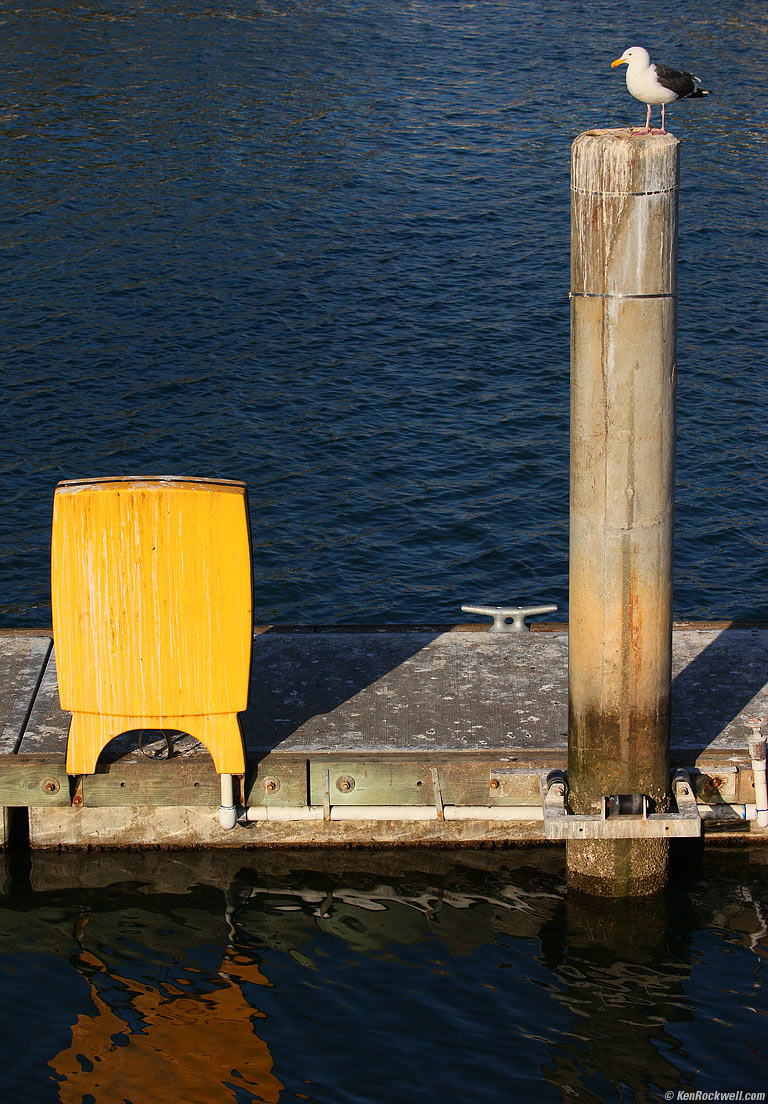
Yellow and Blue, 4:21 PM. (Canon 5D Mark II, Canon EF 80-200mm f/2.8 L at 103mm, f/8 at 1/1,000 at AUTO ISO 200 D+.)
This snap's all about balance. The bird and yellow rectangle balance, and of course the yellow comes three-dimensionally forward against the blue sea.
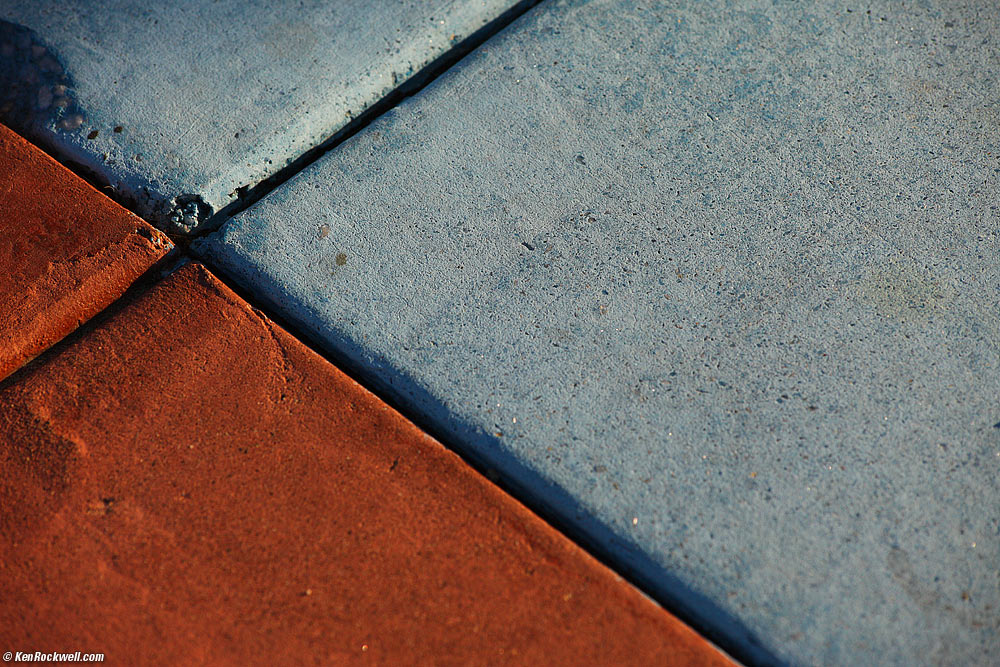
Blue Concrete, 4:29 PM. (Canon 5D Mark II, Canon EF 80-200mm f/2.8 L at 200mm, f/7.1 at 1/1,250 at AUTO ISO 200 D+.)
Shapes and colors. This would have been even stronger in black and white.
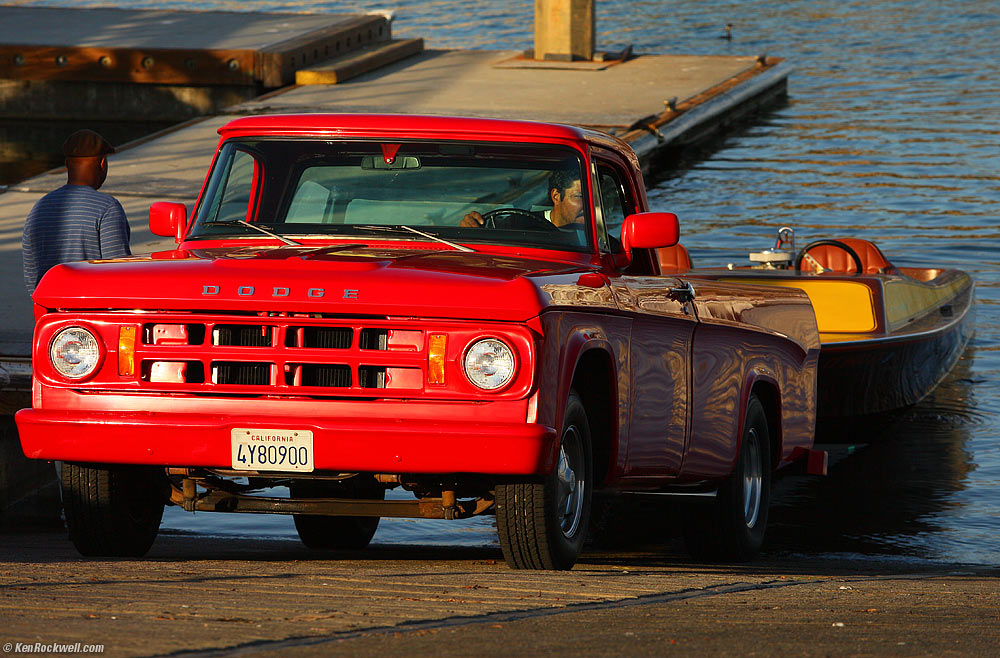
Red Truck, 4:37 PM. (Canon 5D Mark II, Canon EF 80-200mm f/2.8 L at 200mm, f/6.3 at 1/800 at AUTO ISO 200 D+.)
Red pushes forward from blue, too. A blue truck popping out of a red background wouldn't have worked.
After the marina, we popped over to Oceanside Pier, the world's longest west-coast wooden California pier.
Here's one to get us warmed up:
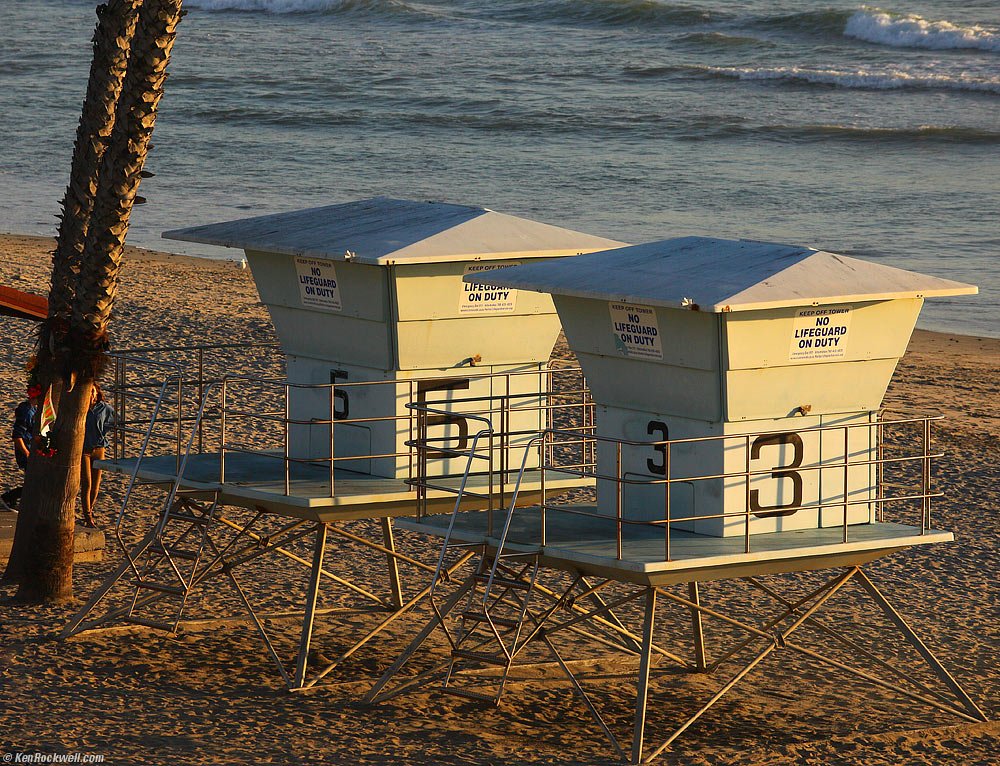
Lifeguard Stations, 5:11 PM. (Canon 5D Mark II, Canon EF 80-200mm f/2.8 L at 200mm, f/6.3 at 1/800 at AUTO ISO 200 D+.)
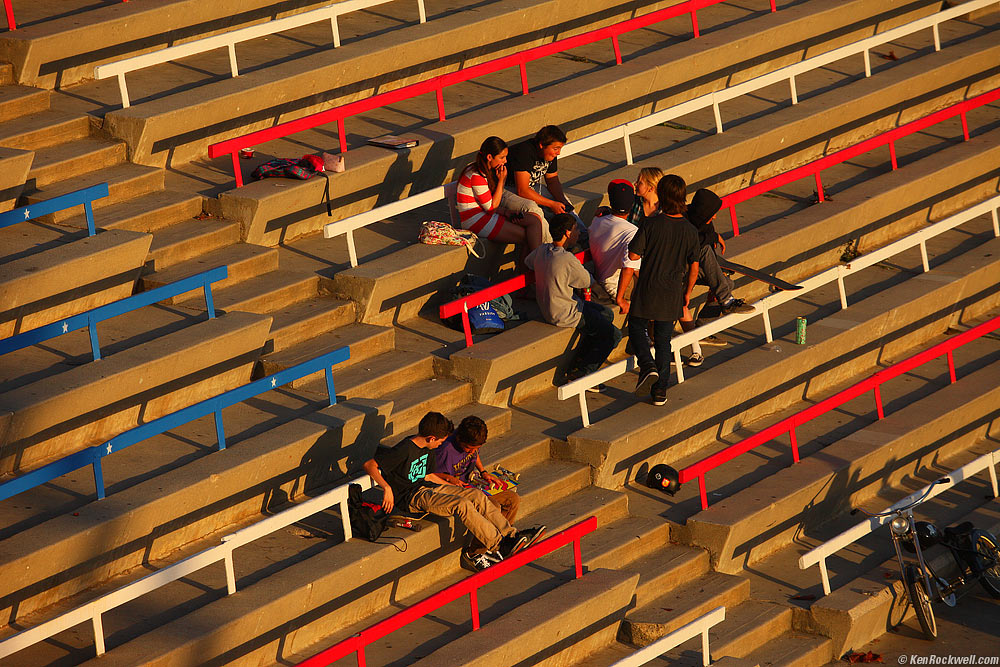
US Flag, 5:11 PM. (Canon 5D Mark II, Canon EF 80-200mm f/2.8 L at 200mm, f/6.3 at 1/800 at AUTO ISO 200 D+.)
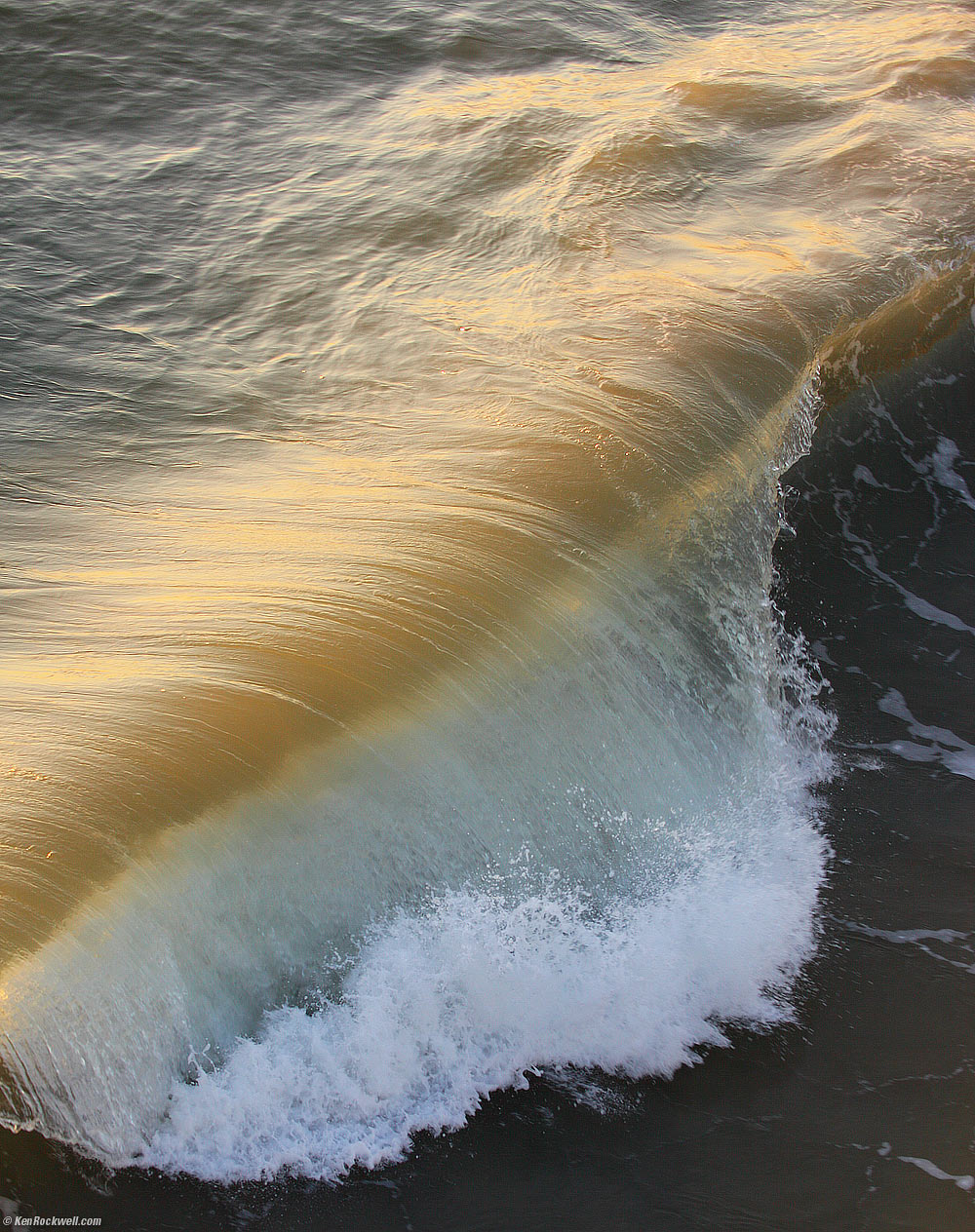
Wave, 5:23 PM. (Canon 5D Mark II, Canon EF 80-200mm f/2.8 L at 200mm, f/5 at 1/250 at AUTO ISO 200 D+.)
Yes, 1/250 stops water. I never need faster than 1/500 for stopping action; higher speeds have always just been needless features added to try to sell more cameras — or mitigate the problems with ISOs that are too high on the new "digital" cameras.
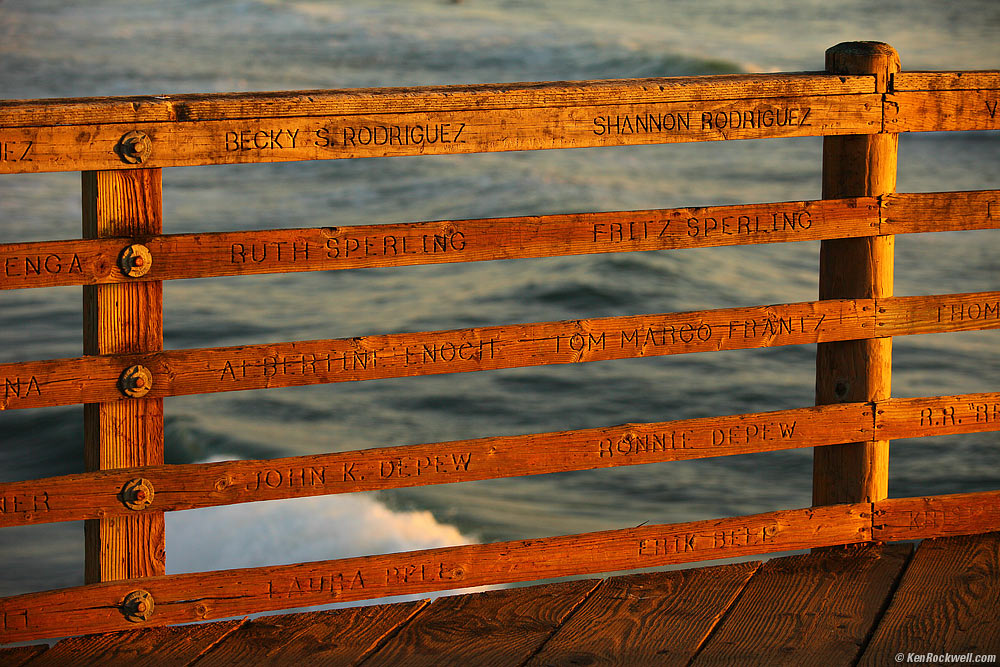
Pier Fence, 5:25 PM. (Canon 5D Mark II, Canon EF 80-200mm f/2.8 L at 120mm, f/5.6 at 1/400 at AUTO ISO 200 D+.)
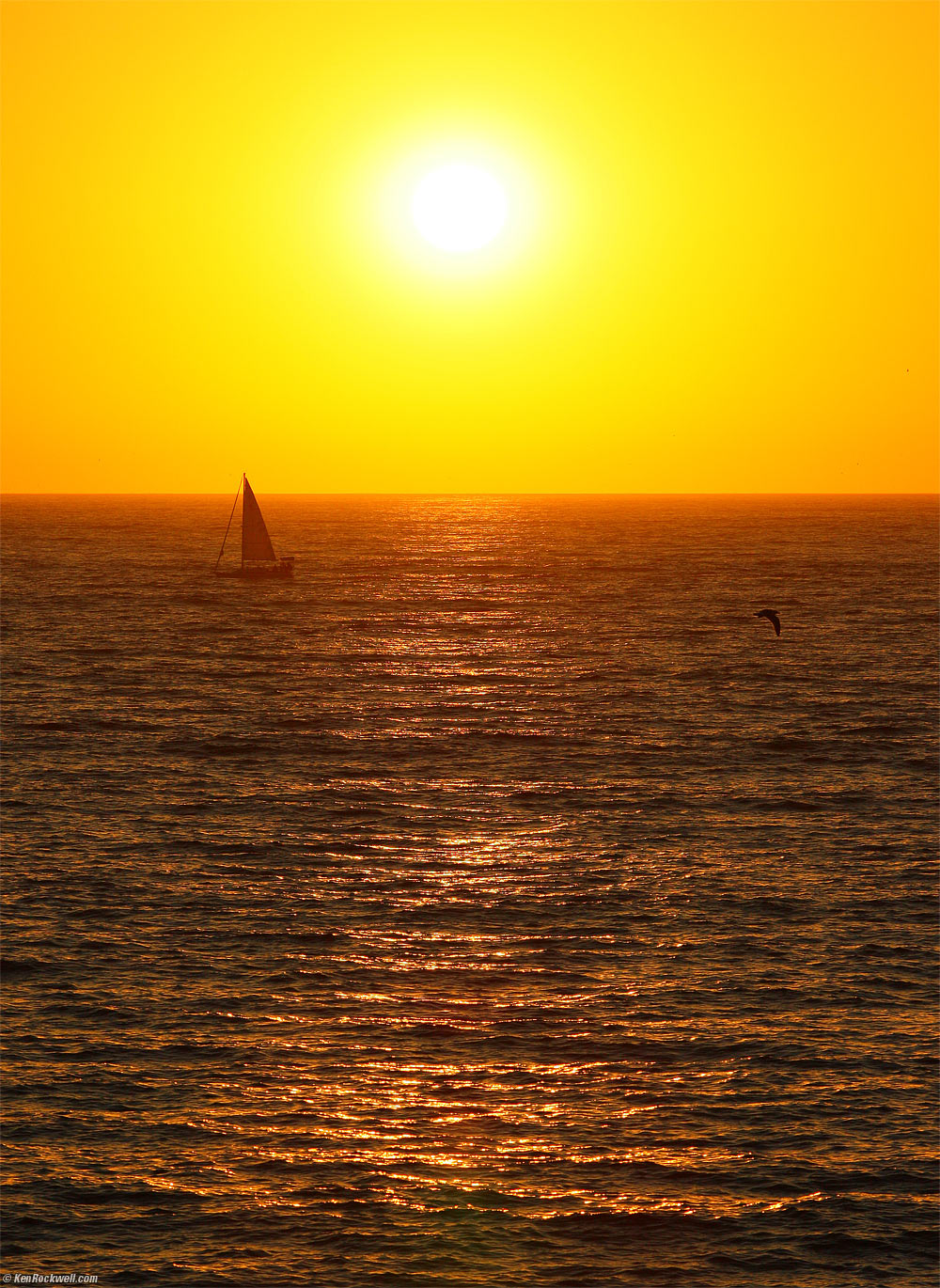
Another Sunset Snap, 5:36 PM. (Canon 5D Mark II, Canon EF 80-200mm f/2.8 L at 200mm, f/8 at 1/1,600 at AUTO ISO 200 D+.)
Ho hum. The ring around the sun comes from the dynamic limitations of digital capture; film never has this problem.
Let's find a clichéed foreground.

Fishermen, 5:45 PM. (Canon 5D Mark II, Canon EF 80-200mm f/2.8 L at 200mm, f/5.6 at 1/800 at AUTO ISO 200 D+.)
Blah blah blah. I wait all day to get ten minutes of this:
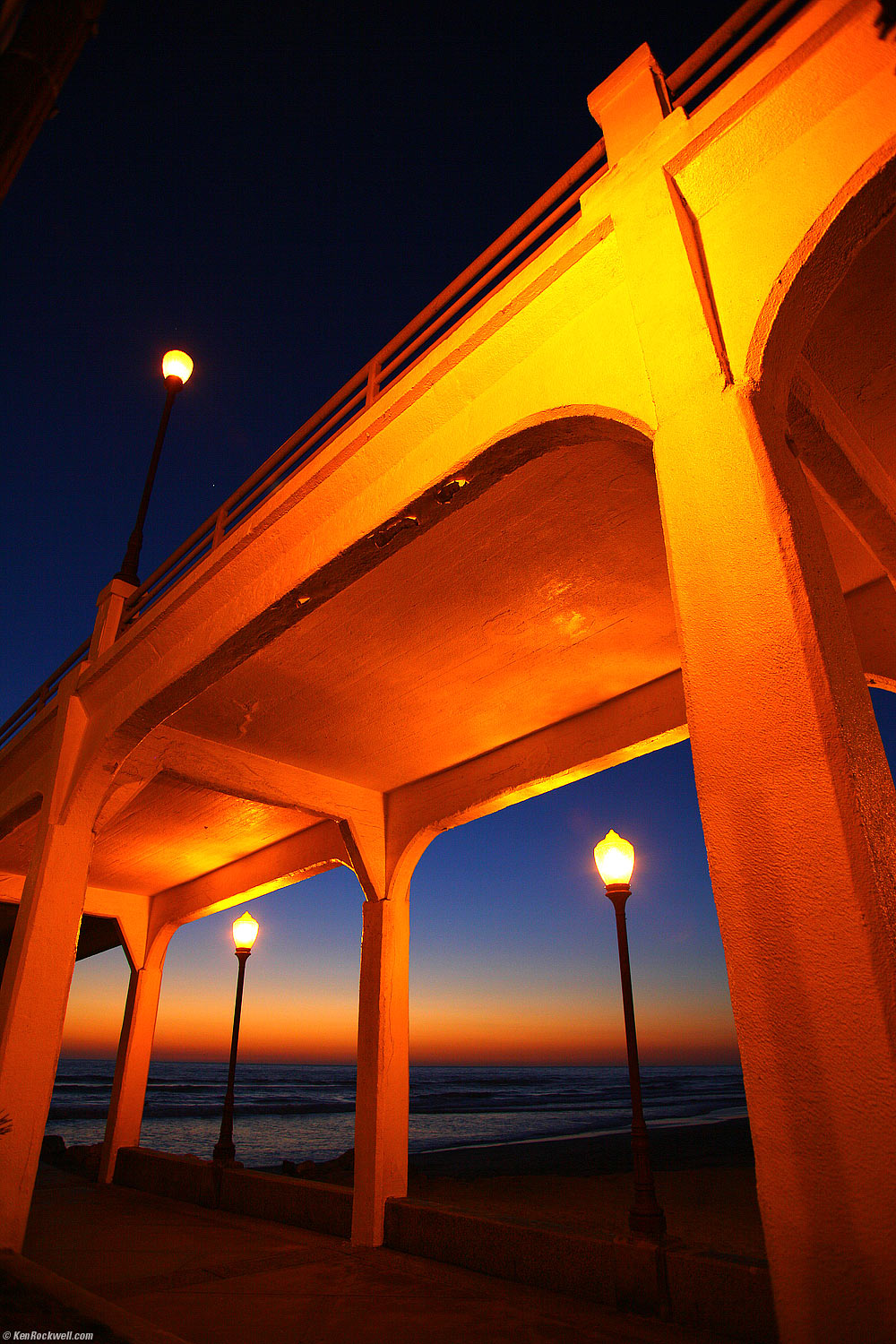
G-d, 6:10 PM. (Canon 5D Mark II, Canon EF 20-35mm f/2.8 L at 20mm, f/3.5 at 1/50 at AUTO ISO 200 D+.)
YES!!!! I wait for this. It looked nothing like this to the naked eye, and as I've learned over the decades, the artificial light on the concrete explodes into orange, while the dim sky goes deep blue. To our eyes at the time, it was all kind of gray.
No tripod used; why would I waste my time and sacrifice creative freedom?
To our eyes, this was blah, but as I knew and showed everyone, the camera, especially with good film or a jacked-up saturation setting with a "digital" camera, the colors pop.
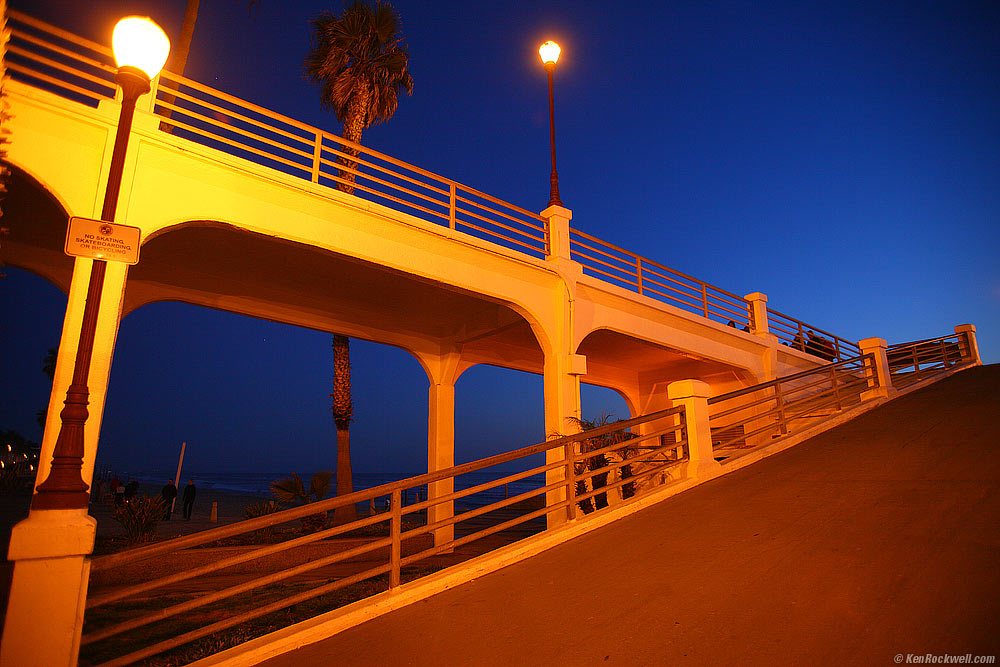
Orange Triangle, 6:11 PM. (Canon 5D Mark II, Canon EF 20-35mm f/2.8 L at 20mm, f/2.8 at 1/15 at AUTO ISO 250 D+.)
No tripod used; why would I waste my time and sacrifice creative freedom?
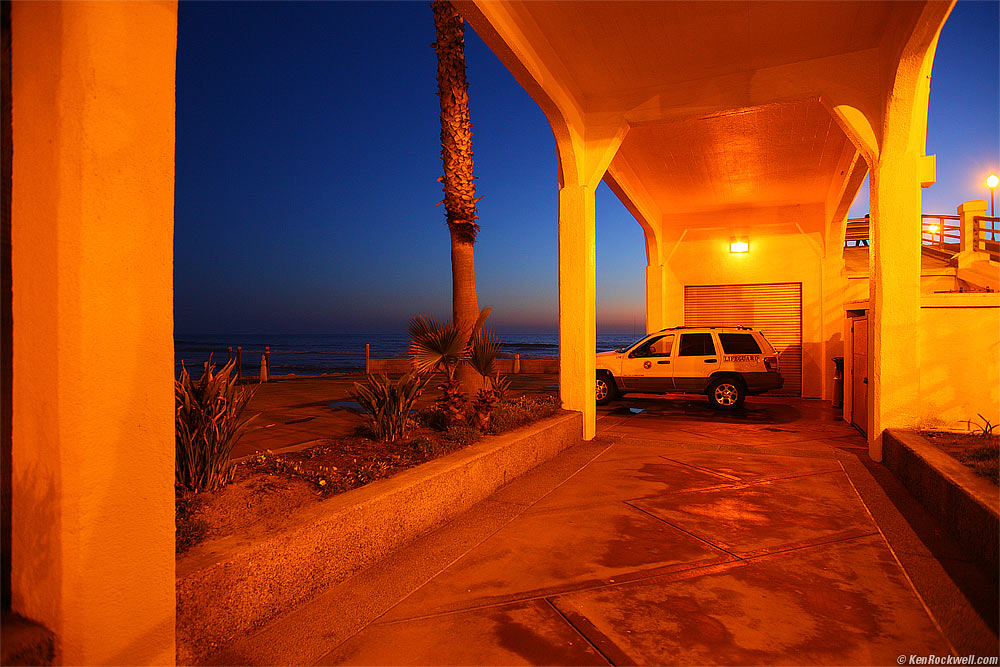
Orange Lifeguard, 6:17 PM. (Canon 5D Mark II, Canon EF 20-35mm f/2.8 L at 20mm, f/4 at 1/8 at AUTO ISO 640 D+.)
No tripod used; why would I waste my time and sacrifice creative freedom?
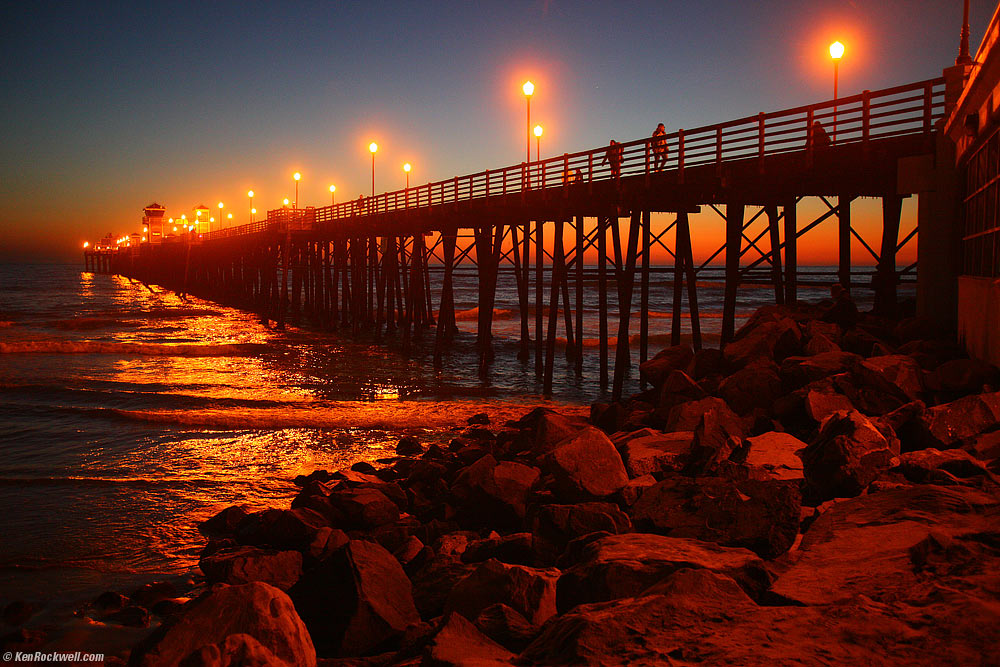
Boring Pier Shot, 6:21 PM. (Canon 5D Mark II, Canon EF 20-35mm f/2.8 L at 20mm, f/2.8 at 1/40 at AUTO ISO 1,600 D+.)
Boring; everyone makes this snap. Let's see what else we can find. (No tripod used.)
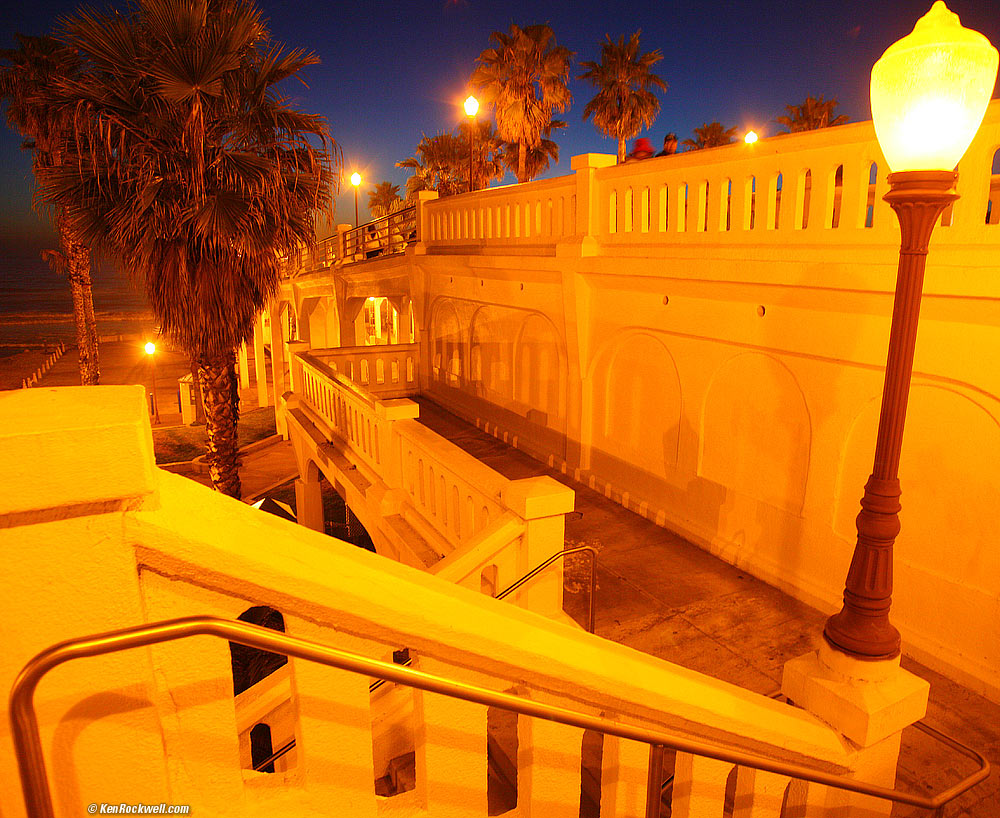
Orange Stairs, 6:27 PM. (Canon 5D Mark II, Canon EF 20-35mm f/2.8 L at 20mm, f/4 at 1/8 at AUTO ISO 1,000 D+.)
No stinking tripod.
OK, let's call it a night.
That's all for today. NEXT ->> Saturday
Home Donate New Search Gallery Reviews How-To Books Links Workshops About Contact
